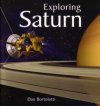Saturn’s Strangely Warm Moon Additional Information
For information about Enceladus, go to en.wikipedia.org/wiki/Enceladus_(moon)(Wikipedia).
Cowen, Ron. 2006. Moon spray. Science News 169(Jan. 7):13. Available at http://www.sciencenews.org/articles/20060107/note11.asp.
Sohn, Emily. 2006. A moon’s icy spray. Science News for Kids (Jan. 11). Available at http://www.sciencenewsforkids.org/articles/20060111/Note3.asp.
______. 2004. Saturn’s new moons. Science News for Kids (Aug. 25). Available at http://www.sciencenewsforkids.org/articles/20040825/Note3.asp.
______. 2004. Ringing Saturn. Science News for Kids (July 28). Available at http://www.sciencenewsforkids.org/articles/20040728/Feature1.asp.
Books recommended by SearchIt!Science:
 |
Exploring Saturn— Dan Bortolotti
Published by Firefly Books, 2003.
“Saturn may be a cold, faraway ball of gas, but its beauty has made it a unique part of our world.” This book’s color photos, diagrams, and illustrations convey the beauty of the sixth planet from the sun, while the text explores many fascinating facets of the ringed planet. Learn about Saturn’s composition, rings, and moons; and find out how scientists measure planetary distances. While the book gives a comprehensive history of how scientists through the ages have explored Saturn’s mysteries, it also devotes much attention to the Cassini-Huygens mission, which will observe and explore Saturn until 2008. The book includes resources for more information as well as charts of the ring system and Saturn’s satellites. |
Power Words
infrared light Electromagnetic radiation that is invisible and has wavelengths that are longer than those of visible light but shorter than those of microwaves. All objects absorb and give off infrared light.
 |
Copyright © 2002, 2003 Houghton-Mifflin Company. All rights reserved. Used with permission.